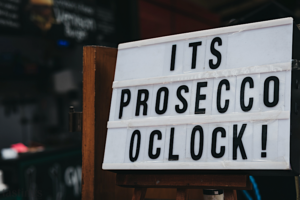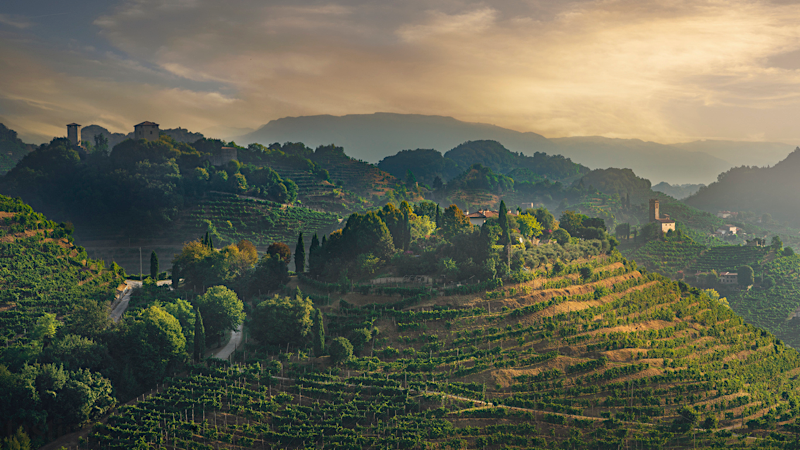There was a time when Prosecco was easy to purchase. At any wine store there were typically five to six different Proseccos. The bottles generally had similar price points with a difference between two to five dollars. Each one had the signature flavors of green apple and blossoms. The only decisions needed were, which is slightly drier and which bottle is more aesthetically pleasing. Now there are many choices and decisions to be made when selecting a Prosecco. Which makes deciphering what the different terms on the label mean is now more important than ever.
How Prosecco is made
Most Prosecco is made using the Martinotti method which is also known as the tank method or the Charmat method. The grapes are picked and pressed either in whole bunches or they are destemmed. The first fermentation is temperature controlled to preserve the aromatics of the grapes, and malolactic conversion is blocked. This preserves the malic acid that gives an aroma and flavor of green apple, and stops the lactic acid, which would otherwise give a softer aroma and creamier mouthfeel, like milk. Prosecco is known for fresh fruit and crisp acidity, so the winemaker doesn’t want to soften the acid. The first fermentation results in a dry base wine. The second fermentation is when the bubbles are made. The base wine is put into a stainless-steel tank along with yeast and sugar. This differs from traditional method sparkling wine that has its second fermentation in the bottle that it will be sold in. The fermentation in the tank creates carbon dioxide which cannot escape the tank and becomes trapped in the wine. The trapped carbon dioxide is what creates the bubbles. As the yeast die, they fall to the bottom and become lees. In Prosecco typically lees contact is not desirable because the longer the wine is in contact with the lees, the more a bread or brioche note will be imparted in the wine, taking away from the freshness. The longer the fermentation lasts the drier the wine will become. The winemaker will stop the fermentation when the wine is at the desired sweetness level. The wine is then filtered and bottled under pressure to keep the bubbles.
Sweetness Levels
The final sweetness level is decided by adding sweetness at the end or more commonly by stopping fermentation when the wine has reached the desired sweetness level. Sweetness levels are consistent throughout the European union and are on the label of the bottle for sparkling wine. Sometimes the sweetness levels are proudly displayed on the front label and sometimes they are in small print on the back label.
Each level has a range and some of the levels overlap. The sweetness levels are grams per liter of residual sugar. The residual sugar in sparkling wine is often about creating balance with the fresh acidity as opposed to adding a sweet taste.
European Union Sweetness Levels:
Brut Nature 0 g/l
Extra Brut 0-6 g/l
Brut 0-12 g/l
Extra Dry 12-17 g/l
Dry 17-32 g/l
Demi Sec 32-50 g/l
Doux 50+ g/l
The Grapes
Prosecco comes mainly from the Glera grape (Glera Tondo). Glera will constitute a minimum of 85% of the blend. The rest of the blend is comprised by any mix of approved local varieties such as Verdiso or Glera Lungo as well as international varieties such as Pinot Noir and Chardonnay. For a long time Glera was referred to as its synonym Prosecco. With both the grape and the region using the same name it can be a bit confusing. It also made it impossible to protect the region of Prosecco. Grape names can typically be used for making wine anywhere in the world. Think about how many different countries make Cabernet Sauvignon. Wineries were making Prosecco all around the world. That is why the region reverted to the grapes’ original name of Glera allowing the region for Prosecco to be protected by the European Union – just like Barolo, Bordeaux, or Champagne. Now all Prosecco should come only from Italy and more specifically from three different regions: Prosecco DOC, Conegliano Valdobbiadene Prosecco DOCG, and Asolo Prosecco DOCG.

Prosecco DOC
For the wines of Prosecco DOC, the grapes are sourced, and the wines are made in Veneto or Friuli Venezia-Giulia. Often these are where the larger producers make wine because they can source grapes from a much larger area and make more wine. The typical style of these wines is fresh, bright and fruit forward. The wines can be frizzante (semi-sparkling), spumante (fully sparkling) or rosé. Rosé is a newer category in Prosecco DOC. It is made by adding 10%-15% Pinot Nero (Noir) that has been vinified red. Rosé Prosecco must be vintage dated. White Prosecco that uses Pinot Noir vinifies it with no skin contact making it a white wine. Rosé sparkling wine has been made in the region for a long time, but recently (2020) was allowed to label itself as Prosecco. There is also a very rare and elusive Tranquillo style, which is still Prosecco that is typically only found in Italy. There are other important labels for Prosecco DOC. “Provincia di Treviso”, “Treviso”, or “Trieste” means the grapes were only harvested from that area. “Rifermentazione in bottiglia” means the wine went through its second fermentation in a bottle and has a slightly lower acidity. Wines labeled Prosecco Spumante can be labeled with sweetness levels of Brut Nature through Demi Sec. Rosé Prosecco can be Brut Nature through Extra D
Conegliano Valdobbiadene Prosecco DOCG
This DOCG was named after the two towns near where the grapes must be sourced from, which was the original area for Prosecco before it was expanded. This is a growing category with smaller levels of production than Prosecco DOC and a higher quality level. There are several categories within this region. Tranquillo, frizzante and frizzante “rifermentazione in bottiglia” exist. Rosé is not allowed to be made in this area. Other styles include Spumante Superiore which can be a stand-alone style or have Sui Lieviti, Rive, or Cartizze on the label. Sui Lieviti means on the lees. These wines are made and bottled in contact with the lees from the wine, and will be cloudier because of the sediment. Rive indicates the use of specific vineyards. The wine can be from a single vineyard or from multiple vineyards. The grape must be hand harvested and the wine vintage dated. Cartizze is a subzone. It is considered the best site for growing Glera in the entire region of Prosecco. It is also one of the most expensive vineyards in Italy. The wines have a fuller body and tend to be made in the Dry category of sweetness level. All other wines from Conegliano Valdobbiadene have a range of sweetness levels.

Asolo Prosecco DOCG
The smallest of the Prosecco regions, it overlaps with a region that produces red wine, but the amount of Prosecco made is growing. Frizzante, frizzante “rifermentazione in bottiglia”, Spumante Superiore and Spumante Supriore Sui Lieviti are different styles. Here if Sui Lieviti is made it must be Brut Nature with all grapes coming from a single harvest. These wines are also fermented in bottle with a minimum of 90 days on the lees and the lees are left in the bottle. All other Prosecco styles from this region can have a range of sweetness levels.
The world of Prosecco has become a much larger category of wine and can be more difficult to decipher. These descriptions of Prosecco hold the key to knowing what is in your bottle and understanding why there is a greater range of styles and prices than ever before.
Have a great National Prosecco Week and to learn more checkout https://nationalproseccoweek.com/

